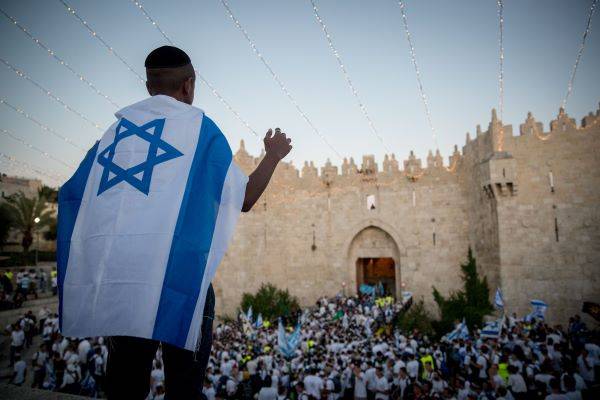Today, once again, the Muslim world has taken to claiming Jerusalem as a pinnacle of its religious aspirations – and its political interests this time are simply to rid the Middle East of Israel.
By Hillel Fendel and Chaim Silberstein, www.KeepJerusalem.org
The bottom line, so far, of what appears to be the most hyped peace proposal in most of our lifetimes is that Jerusalem – all of it – is Jewish and Israeli, and will remain so. But will it, intolerably, lead to a Palestinian state?
U.S. President Trump’s Deal of the Century recognizes Jerusalem as Israel’s undivided capital, and assigns the capital of a Palestinian Arab state, if it ever arises, to be established in neighborhoods in eastern Jerusalem. (This seeming contradiction will be explained below).
Israel is recognized as being the only regime that has granted freedom of access and worship in all religious sites, and therefore will continue to oversee all holy sites in the contested areas. Members of all religions will be able to worship on the Temple Mount, where the status quo (allowing only Muslims the ability to worship there) will be maintained. (This blatant contradiction cannot be explained, below or anywhere else.)
Much of the confusion regarding Jerusalem’s status in the Trump Deal concerns the placement of the Arab capital. Will it be outside Jerusalem altogether, or in its eastern neighborhoods? The answer is based on the question of how to look at Jerusalem’s complex and often fluctuating borders. The many changes in the city’s borders over the past century – determined by the British Mandate, Israel’s independence, Jordanian control over eastern suburbs, and changes legislated by Israel in 1967 and afterwards – have left several neighborhoods in a state of uncertainty.
Among these are those designated by the Trump Team for the new Arab capital. Most notably, Abu Dis – roughly southeast of the Old City – has been touted as the site on which the Arabs of the Land of Israel would build their seat of government. Part of Abu Dis is inside the city’s municipal borders, most of it is not, and the security barrier leaves it physically outside Jerusalem. Notably, most of the PA offices responsible for Jerusalem affairs are already located in Abu Dis.
The Deal mentions two other Arab-populated neighborhoods as options for detraction from municipal Jerusalem and placement of Palestinian government offices: Shuafat and Kafr Akeb. The former is located roughly between Pisgat Ze’ev and French Hill, while Kafr Akeb is in the northern tip of municipal Jerusalem. Both are partly or totally set apart from Jerusalem by the security barrier.
Israel basically has little problem with this part of the plan, and is not likely to demand that these three neighborhoods remain under full Israeli control. Arab governmental headquarters could easily be built there without undermining “united Jerusalem under Israeli sovereignty.”
Muslim Jerusalem – A False Notion
From the Arab standpoint, however – which is based on the false notion that Jerusalem has always been a holy Muslim site and the pinnacle of their political aspirations – this is unacceptable. As PA Chairman Mahmoud Abbas said, “I will not go down in history as the man who sold Jerusalem.”
How can one “sell” something that is not his?!
Let us briefly review why Jerusalem has not “always been a holy Muslim site” and why it has never permanently been “the pinnacle of Arab political aspirations.”
Historically, Muslim ties to Jerusalem have always been based on little more than political expediency, disguised as religious fervor. The first time Islam artificially enhanced Jerusalem was during Muhammad’s own lifetime. In a barefaced attempt to win over the Jews living near his hometown of Medina, he announced that prayers would be directed towards Jerusalem. However, as soon as he saw that the Jews were not interested, he made a brutal about-face and slaughtered many of them. He then directed prayers in a different direction, towards Mecca.
Mohammed’s abandonment of Jerusalem was so total that he did not mention the city even once in the Koran.
Some decades after Muhammed’s death, Caliph Abdel Malik sought a response to the capture of Mecca and Medina by a rival Muslim leader – and came up with the idea of renewing Jerusalem as “top holy city”! But again, its importance was soon eclipsed when Ramle was built, in the eighth century.
The third Muslim infatuation with Jerusalem occurred during the 12th-century Crusades. Salah a-Din needed to inflame his Moslem warriors against the Christian Crusaders – and Jerusalem again briefly became the focus of jihad and religious longing. In case you ever wondered what beautiful praises of Jerusalem appear in the Arabic inscriptions adorning the Dome of the Rock – the answer is that they make no mention of Jerusalem per se; only the triumphant refurbishing of the dome is described. Not surprising, considering the Muslims’ “use and dispose” approach to Jerusalem over the centuries…
Today, once again, the Muslim world has taken to claiming Jerusalem as a pinnacle of its religious aspirations – and its political interests this time are simply to rid the Middle East of Israel. As recently as 1964, when the PLO was founded, its original charter did not even mention Jerusalem!
Yet now, Arab spokesmen highlight the city’s “sanctity” and how they will never “sell” or “abandon” it.
An Existential Danger to Israel?
Back to the Trump Plan: Possibly its biggest danger is that the Arab world might actually accept it – possibly leading to an existential danger to Israel in the form of a Palestinian state. However, it seems that the way they have contrived their history and feelings towards Jerusalem will actually prevent them from ever doing so.
Aside from Jerusalem, whether the Deal of the Century is actually a worthy one for Israel appears to be the subject of much uncertainty. It must be first made concretely clear that any form of another Palestinian state – in addition to Jordan – is totally intolerable.
However, this must also be said: The deal unprecedentedly recognizes the Jewish presence in Judea and Samaria as totally legitimate. From this angle, it is the realization of decades of dreams on the part of the “settlement enterprise” visionaries, leaders and residents.
In addition, it recognizes that the Jordan Valley is an essential part of Israel’s security needs. It also helps us realize the incredible folly of previous Israeli leaders, such as former Prime Ministers Barak and Olmert, who actually offered the Palestinian Authority more than 90% of Judea and Samaria on which to build a hostile Palestinian state. It is mind-boggling to think how close we were to such a calamity, and how far it now appears to be.
On the other hand: Is it truly viable for 15 small Jewish communities to remain in isolated enclaves almost totally surrounded by a Palestinian state? And what about the other communities – they, too, will be surrounded by the same, even if only on a less-obvious scale.
And can Israel truly afford to allow even a demilitarized, pock-holed state on its borders and in its midst? After all, as analyst Dr. Aaron Lerner of IMRA has often pointed out, to agree to a demilitarized state and to actually keep it that way are two different things: Once Palestine is a recognized state, it can then demand the rights of other states – and “let’s see you stop us!”
(This scenario can be neutralized if “Palestine” is recognized not as a state, but only as an autonomy.)
Jerusalem is ours forever – and let us hope that Judea and Samaria are as well.
MAKE THE LAND OF ISRAEL EVEN MORE BEAUTIFUL!
PLANT YOUR VERY OWN FRUIT TREES IN ISRAEL!
Farmers near the Gaza border lost family, friends and workers. Spring is here, and they desperately need help to replant the farms. Join us in blessing the People and Land of Israel.
“I will ordain My blessing for you…” (Leviticus 25:4)



